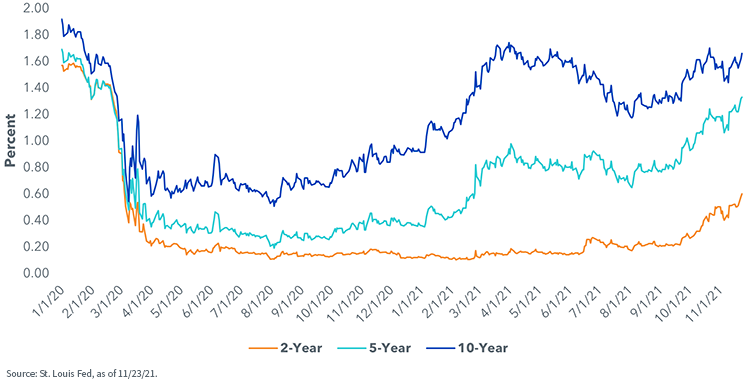Nowhere to Run...With One Exception


Before we started to see omicron-variant headlines, the appointments of Jay Powell to another four-year term as Chair of the Federal Reserve (Fed) and current Governor Lael Brainard as Vice Chair had ushered in a different tone to the money and bond markets. Rightly or wrongly, these markets were operating under the assumption that future Fed policy would tilt to a more ‘hawkish’ stance. If this proves to be accurate, bond investors may have very few options available to them in the fixed income universe other than strategies that seek to mitigate interest rate risk.
Let’s examine how the U.S. Treasury market has responded to this Fed news. Typically, all eyes are on the UST 10-Year yield when discussing the rate outlook. However, we advise also keeping an eye on the 2- and 5-Year notes, the part of the curve that is more closely tied to potential Fed rate hikes. The UST 2- and 5-Year yields have each established new 2021 high watermarks, moved back to pre-pandemic readings and have potentially moved to ‘break-out’ mode to the upside, according to technical analysis.
U.S. Treasury Yields

At the back end of the curve, real yields have been leading the charge with the 10-Year TIPS yield moving up roughly 25 basis points since earlier this month. As far as the UST 10-Year yield is concerned, it has also risen to the upside, but it still hasn’t eclipsed the high watermark of 1.77% that was printed in March of this year, as of this writing.
So, back to the point I raised in the opening paragraph—where can a bond investor turn? The aforementioned hawkish tilt expected by the money and bond markets is really all about the timing and magnitude of any potential rate hikes next year. Pre-omicron headlines, expectations were gravitating toward three Fed rate increases next year, with a potential June lift-off date. Interestingly, in Powell’s first major public appearance since his re-nomination, his comments did take on a ‘hawkish’ tilt. While acknowledging potential economic risks from this new variant, the more noteworthy news were his statements that it is time to “retire” the word transitory when referring to inflation and that the Fed can consider ending their taper program a few months sooner.
In this type of an environment, the fixed coupon and TIPS portion of the Treasury yield curve could see higher yields in the months/year ahead. In other words, short duration and inflation-protected strategies would still be vulnerable to rate risk.
Conclusion
There is one Treasury-based, time-tested strategy to help mitigate rate risk: Treasury Floating Rate Notes (FRNs). Treasury FRNs reset with the weekly 3-month T-Bill auction, so the yield historically ‘floats up with the Fed’ during a rate hike cycle. The WisdomTree Floating Rate Treasury Fund (USFR) offers investors a means to tap into this solution.
Important Risks Related to this Article
There are risks associated with investing, including the possible loss of principal. Securities with floating rates can be less sensitive to interest rate changes than securities with fixed interest rates, but may decline in value. The issuance of floating rate notes by the U.S. Treasury is new and the amount of supply will be limited. Fixed income securities will normally decline in value as interest rates rise. The value of an investment in the Fund may change quickly and without warning in response to issuer or counterparty defaults and changes in the credit ratings of the Fund’s portfolio investments. Due to the investment strategy of this Fund it may make higher capital gain distributions than other ETFs. Please read the Fund’s prospectus for specific details regarding the Fund’s risk profile.


